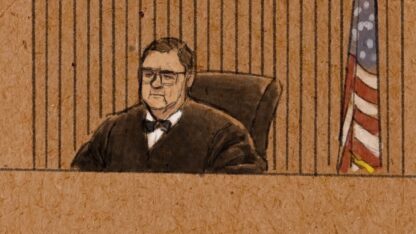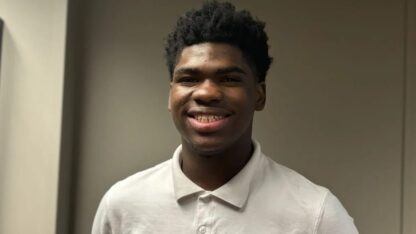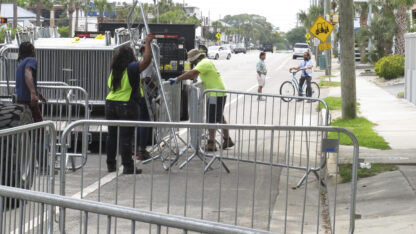Congress And COVID-19: Members’ Cases And Quarantines

The U.S. Capitol, seen here on April 13, remains closed to public tours and open only to members, staff, press and official business visitors.
Al Drago / Bloomberg via Getty Images
Updated on Feb. 8 at 12 p.m. ET
The coronavirus pandemic for months has upended the daily work of Congress, which has seen a series of outbreaks.
Most recently, the Jan. 6 violent insurrection at the Capitol forced members to cluster together in rooms for several hours. Some House Republicans were seen not wearing masks during the ordeal, and refusing to do so.
And at least one holding room for House members included a lawmaker who was already positive, the Capitol attending physician told Congress.
“During this time, individuals may have been exposed to another occupant with coronavirus infection,” said Dr. Brian Monahan, who urged members to seek testing.
Several members quarantined as a result of the concerns and at least one tested positive, including New Jersey Democratic Rep. Bonnie Watson Coleman.
This, as a wave of lawmakers have received the first shot of the Pfizer-BioNTech COVID-19 vaccine, which is now available to all members of Congress.
Senate Majority Leader Mitch McConnell, House Speaker Nancy Pelosi and top Senate Democrat Chuck Schumer were among the first to take part in the vaccinations.
The doses were provided to meet long-standing requirements for continuity of government operations, Monahan told members in a Dec. 17 note.
Still, by January, more than 50 lawmakers and 220 workers have tested positive, or were presumed so, for the illness.
A congressman-elect from Louisiana, Luke Letlow, died on Dec. 29 from the illness, days before he was due to be sworn in with a new Congress on Jan. 3. And this past summer, a Florida member’s aide died from COVID-19.
Ahead of the vaccinations, both chambers of Congress recessed multiple times throughout the year as the Capitol went largely without a widespread testing program.
The Democrat-controlled House installed emergency proxy voting and remote hearings in May. And in November, Pelosi triggered a broader COVID-19 testing program for Congress following new requirement for travelers to the Washington, D.C., area.
But efforts to test as many as 2,000 a week still falls short for a Capitol complex that includes more than 530 lawmakers and a workforce of 20,000 or more.
In December, at least nine House members, including six Republicans, tested positive for the illness. A month earlier, at least 13 House members were also positive, including the oldest member, Alaska Republican Don Young.
A previous outbreak in September was tied to a White House Rose Garden ceremony to announce Amy Coney Barrett as President Trump’s Supreme Court justice nominee. Trump, first lady Melania Trump and dozens of others in attendance tested positive, including Republican Sens. Mike Lee of Utah and Thom Tillis of North Carolina.
It was one of several instances forcing leaders to change the schedule.
Starting in March, House and Senate leaders delayed bringing back members for several weeks in light of public health guidelines recommending social distancing.
The Senate returned in May, but the much larger House still stayed mostly away under the advice of Dr. Monahan. That same month, the House approved historic rule changes to allow remote voting and hearings.
The initial rash of cases began March 8, when two Republican lawmakers, Sen. Ted Cruz of Texas and Rep. Paul Gosar of Arizona, were the first members of Congress to announce self-quarantines. Both attended the Conservative Political Action Conference in National Harbor, Md., where another guest fell ill.
The following week, the first two members of Congress said they tested positive for the coronavirus illness. Republican Rep. Mario Diaz-Balart of Florida and Democratic Rep. Ben McAdams of Utah both said they developed symptoms after a March 14 vote on a coronavirus relief package.
By this summer, dozens of Capitol workers reported a positive test or were presumed so, and Gary Tibbetts, a longtime staffer for Republican Rep. Vern Buchanan of Florida, died from COVID-19 on July 24.
Some lawmakers have taken antibody tests to see if they were previously ill. Among them, Democratic Sens. Tim Kaine of Virginia and Bob Casey of Pennsylvania both said they tested positive months after experiencing symptoms in the spring.
To stem the flow of new cases, both chambers early on issued new social distancing guidance. Also, the U.S. Capitol closed to public tours and open only to members, staff, press and official business visitors, and aside from the Jan. breach by pro-Trump extremists, has remained so.
In late July, House Speaker Nancy Pelosi also issued a new mask mandate after Texas GOP Rep. Louie Gohmert, who often rejected mask protocols, tested positive. Gohmert had attended several hearings a day earlier and returned to the Capitol following a White House screening that caught his infection.
Gohmert’s case triggered quarantines for five House members, including Arizona Democratic Rep. Raúl Grijalva. Days later, Grijalva tested positive, but fully recovered symptom free. Now, members can be forcibly removed by Capitol Police if they are not wearing masks.
This story was originally published on April 15, 2020.
9(MDAxODM0MDY4MDEyMTY4NDA3MzI3YjkzMw004))








